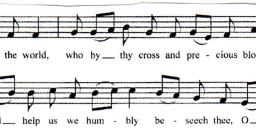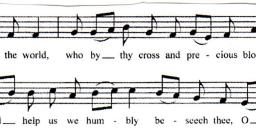Different chant settings of the Mystery of Faith
-
I have searched for these and have been unsuccessful in finding anything. Has anybody written melodies for the mystery of faith that correspond stylistically to the Gregorian settings found in the Kyriale? I am relatively new to sacred music (just got introduced to it a year and a half ago), and would like to use the different Gregorian mass settings without having to repeat the same Mortem Tuam for every setting. Thanks for your input!
-
NatePultorak,
Since you're new, I'll assume that my post will be new information to you.
In the older form of the Mass, there is no Memorial Acclamation, and so when the Mortem Tuam was spliced into the Ordo of Pope Paul VI, a melody was borrowed from the liturgy for Good Friday. This melody is sung to the words Crucem Tuam Adoramus, Domine. There were multiple options for the acclamation, but only one melody provided, to the best of my knowledge. Vernacular composers set themselves to the task of writing music for the 4 (actually not, but let that pass) possible texts for the Acclamation. The most commonly used text in allegedly conservative parishes is the one which wasn't in the Latin text of the Missal of Paul VI. Most of the musical settings for the other acclamations is boorish, in part because the translation of the texts left so much to be desired. The rule for most of the last 50 years has been "New music good; old music bad". (Yes, that's supposed to sound like Orwell's sheep.) If there are settings available, they're a well-kept secret.
All that said, around here people recommend the work of Fr. Samuel Weber, OSB, or an outfit called Corpus Christi Watershed. There are a few (relatively) newly composed Mass settings, some of which wish to recapture the chant. My family and I don't attend the Mass according to the rite of Paul VI, so I can't tell you if any of those Mass settings are any good, but surely they are the exceptions rather than the rule.Thanked by 1canadash -
You have looked at the three ICEL settings on their website, right? I use Memorial Acclamation "A" because it translates more closely to the meaning of Mortem Tuam.
-
If your are looking for chant settings of the two other Latin acclamations, these can be found here (taken from Psallite Domino, Canti per la Messa by Solesmes).
-
I use Memorial Acclamation "A" because it translates more closely to the meaning of Mortem Tuam.
But the other two aren't meant to be translations of the Mortem tuam, but of
Quotiescumque manducamus panem hunc
et calicem bibimus,
mortem tuam annuntiamus, Domine, donec venias
and
Salvator mundi, salva nos,
qui per crucem et resurrectionem tuam liberasti nos.
I'm not sure why one would have a preference for one over the other. -
I'm not sure why one would have a preference for one over the other.
Because the priest preferred that one. Can you think of a better reason? LOL. Some think the B and C sound a bit contrived or Vatican II happy-clappy-warm-and-fuzzy. I don't know why. I have wondered if that reaction is because of the totally made-up and infamous, "Christ has died..." Who knows? -
The pre-2010 "Christ has died..." acclamation was not "totally made-up." Both it and the second acclamation at that time ("Dying, you destroyed...") were translations (although neither was literal, but dynamically equivalent) of the Latin Mortem tuam annuntiamus, Domine, et tuam resurrectionem confitemur, donec venias.
The thinking in 1969 was: why do we need to say "we announce/proclaim" (annuntiamus) and "we confess/profess" (confitemur) when we are engaged in the very act of announcing and professing when we say "Christ has died, Christ is risen, Christ will come again" or "Dying, you destroyed our death; rising, you restored our life; Lord Jesus, come in glory"?
"I say, you are beautiful." or "You are beautiful." Which is more direct?Thanked by 1M. Jackson Osborn -
While the first acclamation (Mortem tuam) is probably the most popular because it is first, shorter, still obviously based on 1 Cor 11:26, and explicitly mentions the Resurrection as the object of our faith, the second acclamation (Quotiescumque) is the most completely scriptural.
1 Cor 11:26
Quotiescumque enim manducabitis panem hunc et calicem bibetis, mortem Domini annuntiatis, donec veniat. -
The thinking in 1969 was:
OK guys, we have been given an inch. Let's see how many miles we can take. LOL.
Thank the Lord Pope Benedict demanded accurate translations. -
Thank the Lord Pope Benedict demanded accurate translations.
Actually Liturgiam authenticam was promulgated during the pontificate of St. John Paul II. Don't blame it on Pope Benedict. -
Actually Liturgiam authenticam was promulgated during the pontificate of St. John Paul II. Don't blame it on Pope Benedict.
You are correct on the timeframe. CDW March 28, 2001.
LA was a good thing, not bad. After publication of the revised missal, I heard priests whine about such words as "consubstantial" with the complaint that "no one understands it." Why don't they understand it, fathers? Could it be you did a lousy job of teaching and explaining it?
In 1969, having been there and at the age of 22, I encountered many liturgists, authors, musicians, and composers who thought they were far more talented than they actually were. Much of what they produced was faddish and of no lasting value. If we had been blessed with the best and the brightest in those fields, reforms and adherence to L.A. would not have been needed. -
Benedict did insist on pro multis being rendered as “for the many” himself...
-
The Maronite Church's liturgy also has a memorial acclamation and a text similar to Mortem tuam in particular; though I don't know who took it from whom.
They have:
"O God, we remember your death,
we witness that you rose from among the dead,
we await your return.
May your mercy come upon us all."
-
Benedict did insist on pro multis being rendered as “for the many” himself...
If he did so insist, he was not followed. The presently-approved English text is "for many," not "for the many." -
Here is the acclamation that we use at Walsingham. It is rather nice. Chant-like. Mode I. I have no idea of its provenance.
 Thanked by 1eboydston1
Thanked by 1eboydston1 -
Jackson,
While I have no actual use for this (because my usual Mass is EF) I agree with you that this has a chant-like feel, and the skill of Anglican musicians in its syllabification.
Thanked by 1M. Jackson Osborn
Welcome to the MusicaSacra Forum!
To participate in the discussions on Catholic church music, sign in or register as a forum member, The forum is a project of the Church Music Association of America.
Categories
- All Discussions21,106
- General Music Discussion7,594
- Job Openings1,303
- Management of Music Programs833
- Choral Matters519
- Church Documents and Rubrics504
- CMAA Notes291
- Events651
- For Newcomers: Read First23
- Sacred Polyphony528
- Hymnody821
- Gregorian Chant: General2,582
- ↳ Graduale Romanum and Liber Usualis354
- ↳ Graduale Simplex55
- ↳ Semiology57
- Vernacular Plainsong671
- Anglican Use and Anglican Chant66
- Organ, Other Instruments and Repertoire414
- New Composition/Works in Progress1,208
- Recordings222
- Music for Hispanic Ministry151
- Music Education: Children205
- Music Education: General214
- News Items242
- Positions Wanted58
- General Discussion: Catholicism723
- Amusements170
- General Discussion1,000
- Opinions113





